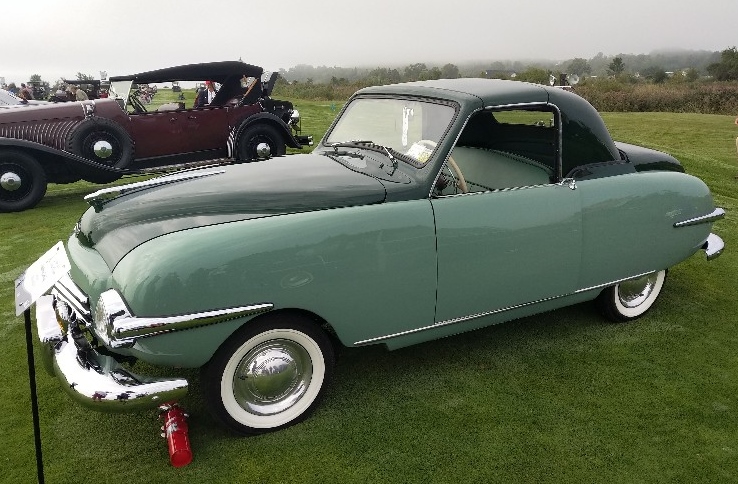The Playboy Motor Car Company of Buffalo, N.Y. should have been a success. It wasn’t, but not for lack of effort on behalf of company founder Lou Horwitz and his partners, engineer Charlie Thomas and car builder Norm Richardson. Horwitz, a Packard dealer, saw the need for cheaper transportation after World War II and pegged the Playboy’s price at $985.
The company finished the first of its 97 hand-built cars – all considered prototypes – in 1947 and showed it off in the lobby of Buffalo’s Hotel Statler on Feb. 18 that year. By the end of December, 1948, it had built its last vehicle.
Like so many other visionaries, including Powell Crosley, Horwitz saw a need for a compact vehicle when none of the major U.S. manufacturers was interested in building one. And none of them would be until Nash introduced its pint-size Metropolitan in 1953 for model year 1954.
Although Crosley’s car was too small, he did manage to sell several thousand before calling it quits in 1952. The larger, more practical Playboy could have been much more successful – had the company’s 35 employees managed to build the 1949 model, for which the dies were ready and the engineering complete. In 1948 a Playboy even had set a transcontinental speed record for its class, travelling from New York to Los Angeles in 62 hours and 20 minutes.
With publicity like that, and the move into a new assembly plant in January, 1948, Playboy’s goal was to produce 100,000 cars per year. But when the company’s first stock offering for 20 million shares was cancelled, that plan had to be revised to a more manageable 12,000 cars per year. However, when a second stock offering to raise $3.5 million also was unsuccessful, Playboy filed for bankruptcy on April 14, 1949.
There was one unfinished car on the shop floor when production ceased and, after several efforts to breathe new life into the company failed, the car was sold to Donald Moore, a former Playboy dealer in Massachusetts. Eventually, that car was obtained by David Kaplan, a grandson of founder Lou Horwitz. It finally was completed in 2017, as Playboy No. 98, and won its First Junior Award at the Antique Automobile Club of America’s (AACA) spring meet in Auburn, Indiana.
The car shown at last month’s Cobble Beach Concours d’Elegance is No. 55, one of three Playboys owned by David Kaplan’s cousin, Lee Singer of Williamsville, N.Y. He told me he had known about the car for nine years before being able to purchase it in Missouri.
Like all the others it is hand-built, and, since no two cars are alike, that posed some interesting problems during its restoration, which Singer says was just finished the week of the Concours.
For instance, the instrument panel is from Studebaker, the taillights are from a 1936 Buick and Singer had to recreate the spinning die that turned out the wheel covers. He also spent 11 months researching the door handles, which were missing. When the cars were under construction in 1948, Playboy used whatever it could find on the shelves of auto parts stores in western New York and Singer deduced the handles came from 1931-1937 Dodge trucks. Unfortunately, shortly after locating a pair, the handles were stolen and Singer says he ended up buying back the filched items when they appeared for sale on the internet.
The first four Playboys were powered by four-cylinder Continental L-head engines making 40 hp. After that, power was supplied by a four-cylinder Hercules engine generating 48 hp, like the one under the hood of Singer’s No. 55. The transmission is a three-speed Borg Warner, with overdrive.
The Playboy also featured some innovations that would be adopted by the auto industry in later years. Not only was it the first car to utilize full unibody construction, it also was the first convertible hardtop. Its unique manually operated steel top was counterbalanced for ease of operation and, when lowered, tucked into a well behind the bench seat. Although billed as a three-seater, because of its narrow width, the Playboy really is comfortable only for two adults.
The Playboy has a 90-inch (2,300 mm) wheelbase and measures 156 inches (4,000 mm) long overall. It rolls on 12-inch rims, and weighs 1,900 lbs. (860 kg) – some 1,430 lbs. less than a 1948 Chevrolet Fleetmaster Sport sedan. Top speed was advertised at 75 mph (120 km/h).
Singer says only about 40 Playboys are known to exist and the first-ever all-Playboy meet in Buffalo last year attracted 16 of them.
And here’s a bit of trivia for you: Legend always had it that the Playboy car was the inspiration for the name of the famous men’s magazine started by Hugh Hefner in December, 1953. That story was confirmed in a letter from Hefner in 2002, that read: “The Playboy name was suggested by a friend whose mother had worked at the then defunct Playboy Motor Car Company.”
Hefner died at the age of 92 on Sept. 27, 2017 without ever owning a Playboy automobile.
However, the Buffalo automaker’s use of the name Playboy wasn’t the first. The Jordan Motor Car Company of Cleveland, Ohio made its Playboy roadster from 1919-1931. It was for the Playboy that Ned Jordan wrote the famous ad titled, “Somewhere West of Laramie.” After its descriptive prose appeared underneath a romanticized image of a young woman behind the wheel of a spirited Playboy in a June, 1923 issue of the Saturday Evening Post, automobile advertising would never be the same.

